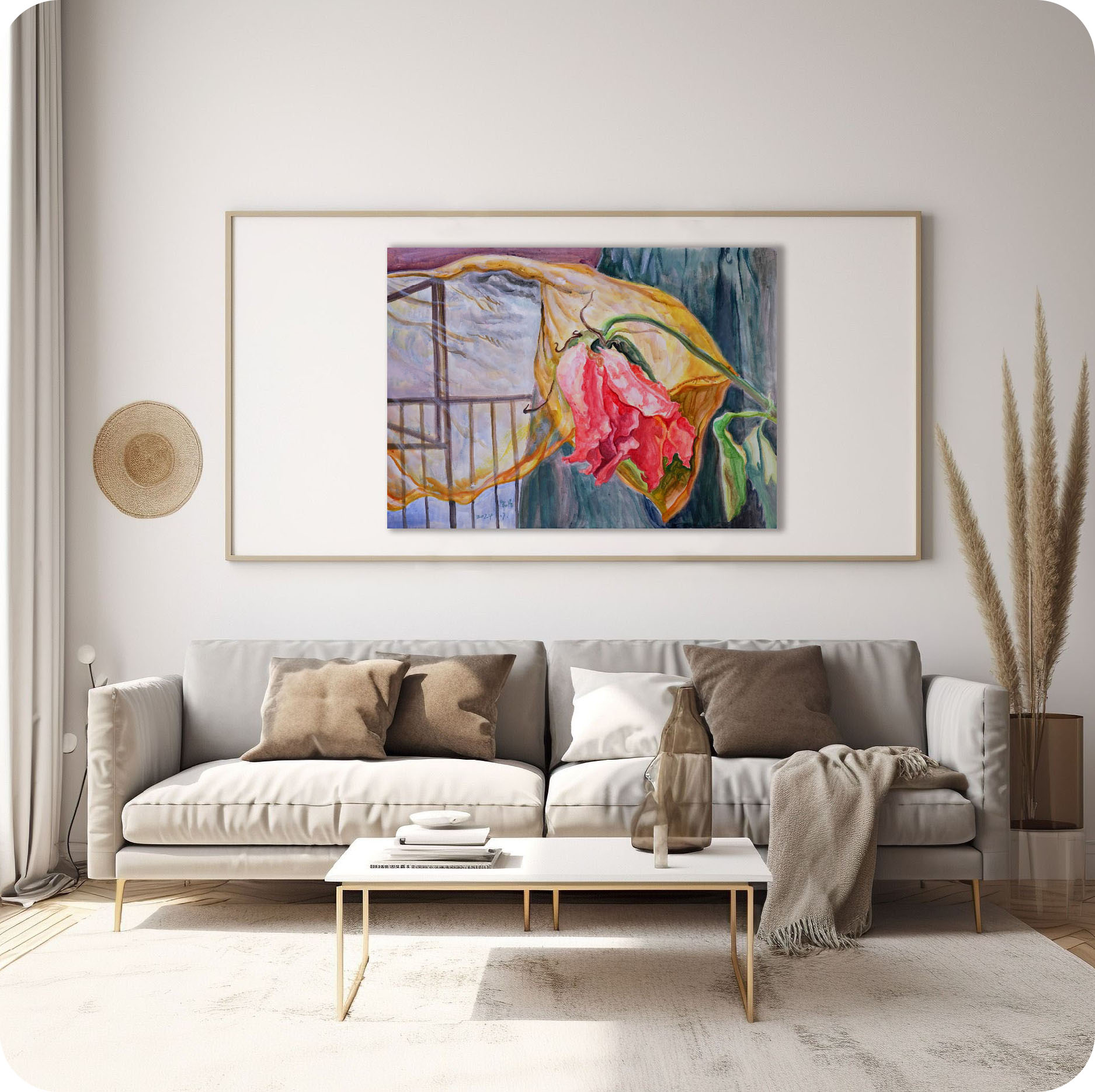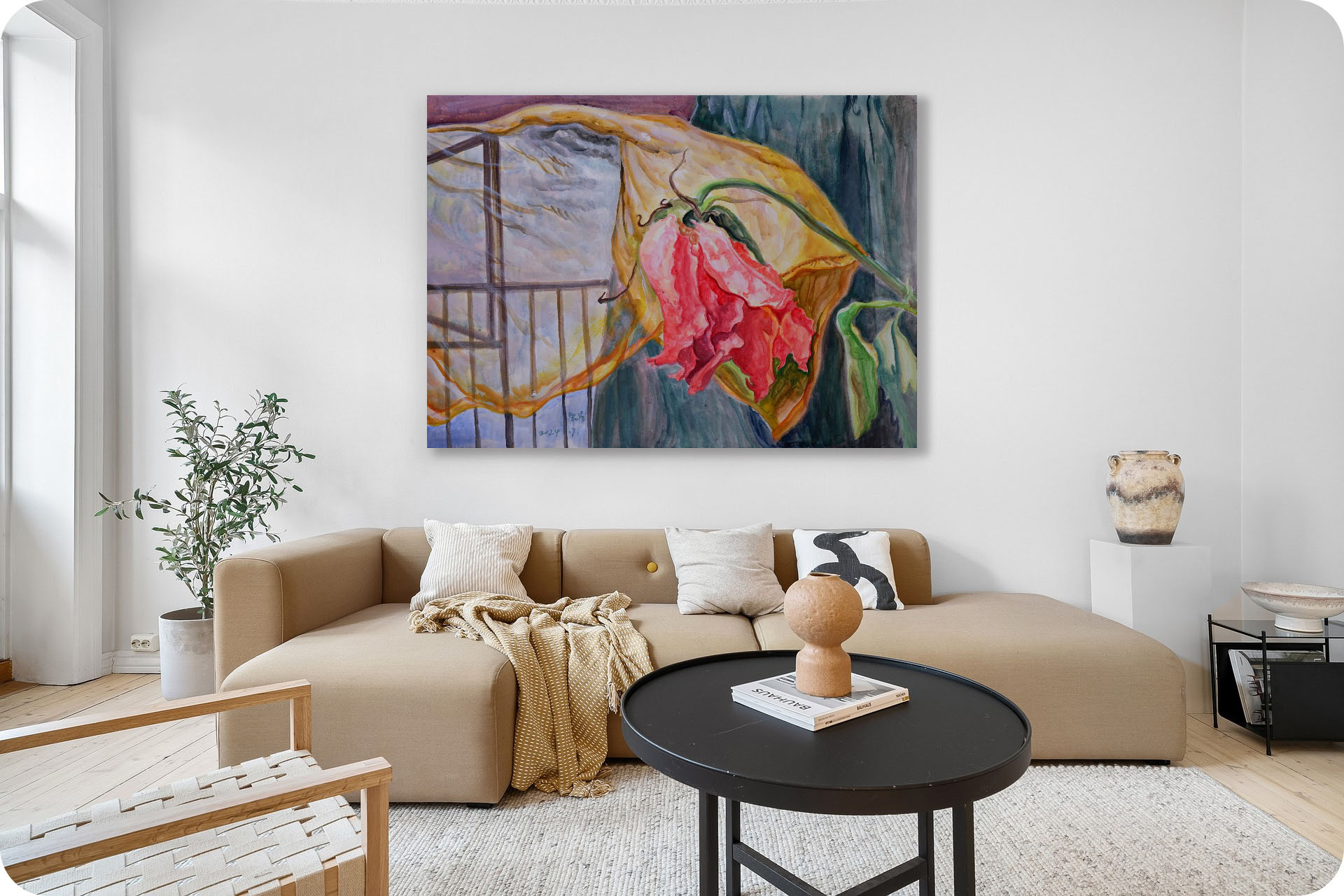This painting was created in 2024. The colors of this year are still bright but not dazzling. I have gradually found a balance point among the bright colors.
A typhoon passed through and there were intermittent strong winds and heavy rain for several days. Typhoon is the temperament of nature. The quarrels and threats of human beings, the manic roar of machines, the passing of time on the pointer, the crying and laughing of new life, the crying and laughing of death... The human voice becomes dead silence in front of the natural voice. At this time, people will suddenly hear the voice in their own hearts, feel lonely, and are frightened and helpless.
Inches: x in
Size without the frame: 39 x 54 cm
Country: China
Date: 2024
Materials: Acrylic paint on paper
Condition: well preserved
Creative themes and style | My works revolve around the creative concept of "The land of humanity, People on the land". The people in the painting are people in nature, and the lines, shapes, and colors are close to nature. The nature in the painting is nature in the eyes of humans, existing in interaction with humans.I don’t pursue a series of works with a fixed and continuous style. I hope that the style of the pictures will synchronize with the changes in my life and always remain oscillating. The performance of the work must be in sync with the development of one's own life in order to be Sincere and powerful. Ideas are later.
An Interview with Artist Philo by Artphiloso Gallery
If you would like to collect this artwork or know more about the artist, please contact us.
fine art websites for artists,website for fine art,best website for art,websites for art,digital art websites for students.


I. Subject and Symbolism
This painting portrays a half-wilted flower draped against a flowing yellow cloth, with a blurred architectural background. The flower, caught between vitality and decline, becomes a metaphor for the fragile persistence of life. The folds of the cloth resemble fragments of memory stirred by the wind, while the faded backdrop suggests the silent passage of time. Together, these elements construct a space of nostalgia and reflection. The word “abandoned” introduces an ambiguity: is the flower resisting oblivion, or is the wind itself recalling what has been left behind?
II. Use of Color
Colors here act as emotional signifiers. The warm reds and pinks of the flower contrast sharply with the muted blues and grays of the background, creating both tension and reconciliation. The yellow fabric, like aged sunlight, mediates between the two, softening the transition from vibrancy to dimness. This interplay underscores a central idea: true beauty and vitality do not vanish in adversity but emerge more profoundly when framed by decline.
III. Expression of Movement
The folds of the cloth, seemingly animated by an unseen breeze, are extensions of the invisible wind. They embody both natural motion and the painter’s imagination, transforming the intangible into a visible presence. The flower, leaning and curling, participates in this dialogue — its gesture echoing both weariness and resilience. In this way, the artwork renders the abstract forces of time and abandonment into touchable, visual whispers.
IV. Philosophical Dimension
Through a modest scene — a flower, a cloth, and the suggestion of a window — the painting conveys a meditation on memory, transience, and hidden beauty. It reminds us that life’s poetry often resides in neglected details: a bloom fading in the corner, a breeze stirring fabric, an object gathering silence. Here, “abandoned” is not an ending but a gentle awakening, urging us to notice the rhythms of fading and to cherish even the most fragile moments of persistence. The artwork becomes a bridge between forgetting and remembrance, transforming the ordinary into a theater of time.
Frida Kahlo, The Broken Column: Symbolic metaphors and intense color reveal the coexistence of suffering and resilience.
Anselm Kiefer, To the Unknown Painter: Layers of material and symbolic imagery evoke the weight of memory and history.
Odilon Redon, Flowers in a Vase: Dreamlike hues and floral imagery construct a symbolic spiritual world.
Sanyu, Withered Flowers: The motif of fading blossoms, paired with restrained tones, conveys solitude and quiet reflection.
The petals shift from deep red to soft pink, layered upon each other with a sense of imminent decay and heaviness. This contrasts sharply with the gray-purple and golden tones of the background, emphasizing a beauty that is both vivid and fading.
The yellow curtain resembles a stage backdrop lifted by the wind, its curling edges seemingly supporting the flowers. This adds a sense of theatricality and dramatic tension to the composition.
The railing-like lines combined with the flowing grays suggest a blurred boundary between interior and exterior. This ambiguity infuses the scene with a tension that feels both constrained and ethereal.
It can be placed within the scope of expressionist still life, both figurative and symbolic. The work is particularly fitting for exhibitions themed around “time and decay,” highlighting the dialogue between human emotions and natural forms.
The painting merges still life with symbolic staging, especially through the pairing of flowers and leaves, giving it the qualities of an “allegorical still life.” Such a piece is well-suited for private collections—displayed in a study or on a dedicated wall—as well as for inclusion in contemporary art museum collections under the category of symbolist painting, where it carries both academic and market value.
A: Click here to view ARTPHILOSO's Guide for Collectors.
More paintings from this series:
